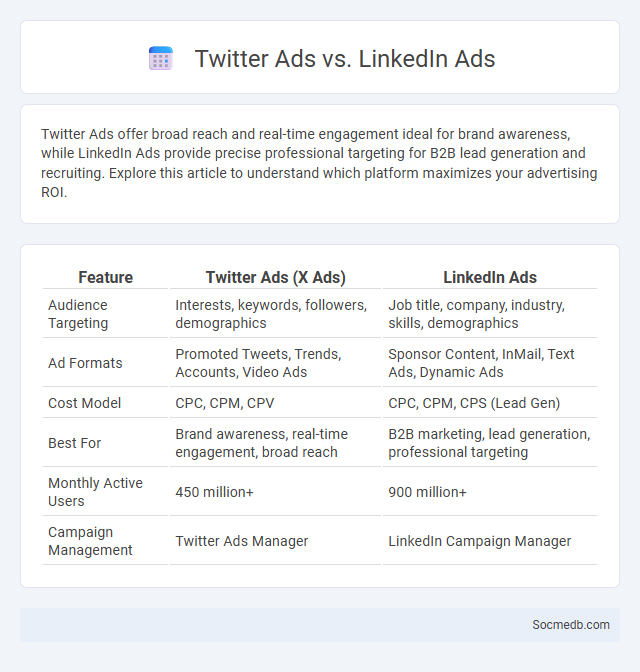
Photo illustration: Twitter Ads vs LinkedIn Ads
Twitter Ads offer broad reach and real-time engagement ideal for brand awareness, while LinkedIn Ads provide precise professional targeting for B2B lead generation and recruiting. Explore this article to understand which platform maximizes your advertising ROI.
Table of Comparison
| Feature | Twitter Ads (X Ads) | LinkedIn Ads |
|---|---|---|
| Audience Targeting | Interests, keywords, followers, demographics | Job title, company, industry, skills, demographics |
| Ad Formats | Promoted Tweets, Trends, Accounts, Video Ads | Sponsor Content, InMail, Text Ads, Dynamic Ads |
| Cost Model | CPC, CPM, CPV | CPC, CPM, CPS (Lead Gen) |
| Best For | Brand awareness, real-time engagement, broad reach | B2B marketing, lead generation, professional targeting |
| Monthly Active Users | 450 million+ | 900 million+ |
| Campaign Management | Twitter Ads Manager | LinkedIn Campaign Manager |
Overview of Twitter Ads, LinkedIn Ads, and Ad Campaigns
Twitter Ads provide targeted options such as Promoted Tweets and Video Ads designed to boost engagement across diverse audiences. LinkedIn Ads focus on professional networking with formats like Sponsored Content, InMail, and Text Ads, ideal for B2B marketing and lead generation. Your ad campaigns can leverage these platforms to maximize reach and conversion by combining Twitter's real-time conversations with LinkedIn's precise professional targeting.
Audience Targeting Capabilities
Social media platforms offer advanced audience targeting capabilities that allow you to reach specific demographics, interests, and behaviors with high precision. By leveraging data such as location, age, gender, and online activity, advertisers can optimize ad spend to engage the most relevant users. These powerful targeting tools enhance campaign effectiveness and drive higher conversion rates by connecting your message directly with the ideal audience.
Advertising Formats and Creativity
Social media advertising formats vary from image ads and video ads to carousel and story ads, enabling brands to tailor their messages for maximum engagement. Creative content that leverages compelling visuals and concise copy increases click-through rates and boosts brand awareness across platforms like Facebook, Instagram, and TikTok. Your success depends on aligning ad formats with audience preferences and continuously testing creative elements to optimize performance and ROI.
Cost Comparison and Budgeting
Social media platforms offer varied advertising costs, with Facebook Ads averaging $0.97 per click and Instagram Ads around $3.56 per click, influencing budget allocation decisions. Effective budgeting requires analyzing cost-per-click (CPC), cost-per-thousand-impressions (CPM), and conversion rates to maximize return on investment (ROI). Tools like Facebook Ads Manager and Google Analytics provide detailed cost tracking and budget optimization insights for social media campaigns.
Campaign Analytics and Performance Tracking
Campaign analytics and performance tracking on social media provide critical insights into engagement rates, conversion metrics, and audience demographics. Leveraging platforms like Facebook Insights, Twitter Analytics, and Instagram Insights, you can measure the effectiveness of your campaigns in real-time and optimize ad spend accordingly. These tools enable precise tracking of click-through rates, impressions, and ROI to maximize your marketing strategy.
Industry Suitability and Use Cases
Social media platforms serve diverse industries including retail, healthcare, education, and entertainment by enhancing customer engagement, brand visibility, and real-time communication. In retail, social media drives targeted advertising and influencer partnerships, while healthcare leverages it for patient education and support communities. Educational institutions utilize social media for remote learning and student collaboration, whereas entertainment industries focus on content promotion and fan interaction.
Engagement Rates and User Interaction
Engagement rates on social media platforms such as Instagram, Facebook, and TikTok are critical metrics for measuring user interaction and content effectiveness. Higher engagement rates, often influenced by likes, comments, shares, and saves, indicate stronger audience connection and improved algorithmic visibility. Brands leveraging tailored content and interactive features like polls and live videos typically see increased user participation and better overall social media performance.
Platform Algorithm and Ad Delivery
Social media platform algorithms prioritize content based on user engagement metrics such as likes, shares, comments, and viewing time to enhance personalized experiences. Ad delivery systems utilize these algorithms to target audiences by analyzing demographic data, browsing behavior, and interaction patterns, maximizing campaign reach and conversion rates. Continuous algorithm updates improve ad relevance and user retention by adapting to changing user preferences and platform trends.
Integration with Marketing Funnels
Integrating social media with marketing funnels enhances lead generation and customer engagement by driving targeted traffic through awareness, consideration, and conversion stages. Platforms like Facebook, Instagram, and LinkedIn enable precise audience segmentation and retargeting, maximizing the efficiency of each funnel phase. Data analytics from social media campaigns provide crucial insights that optimize content strategy and improve overall funnel performance.
Pros, Cons, and Strategic Recommendations
Social media platforms enhance brand visibility and foster customer engagement through targeted advertising and real-time interaction, boosting overall marketing ROI. However, they also pose risks such as data privacy concerns, misinformation spread, and potential negative impacts on mental health. To maximize benefits, businesses should implement robust content moderation policies, leverage analytics for audience insights, and prioritize authentic, value-driven communication strategies.
 socmedb.com
socmedb.com